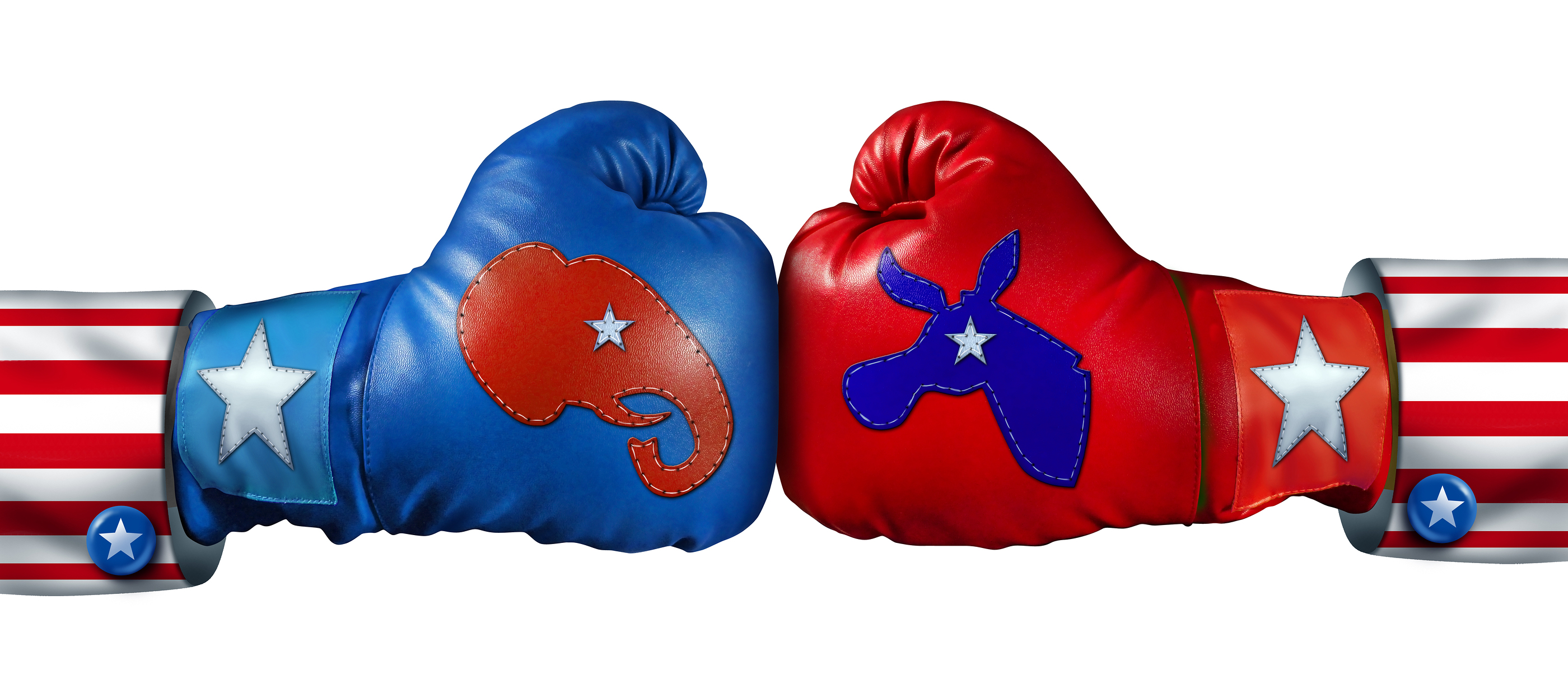
POLITICS & THE ECONOMY | CAUSE & EFFECT
The American economy is essentially based on services. The tertiary sector accounts for more than three-fourths of the GDP and employs over 80% of the country’s workforce.
The U.S. has challenges, both domestic and international, looming in the horizon. American public debt remains high—nearly 105%—and is expected to continue to grow. A strong dollar, paired with weak European and Japanese growth, has had a negative impact on exports, fuelling an already large trade deficit. The presidency of Barack Obama is coming to a conclusion (he is constitutionally barred from seeking a third term) and a new president will be elected in November 2016. Looking abroad, the United States is engaged in seeking solutions to conflicts in Ukraine and the Middle East, as well as addressing the economic slowdown of its major trading partners.

Main Sectors of Industry
The American agricultural sector is one of the world’s largest. It is characterized by high levels of productivity and by the use of modern technologies. The United States is one of the world’s largest producers of corn, soy, beef and cotton. California alone produces more than 12% of the country’s total agricultural output. Nevertheless, agriculture only accounts for 1.4% of the American GDP and employs 1.6% of the workforce. The United States is a highly industrialized country. The industrial sector contributes to over 20% of the GDP and includes a broad range of activities. The most significant are the manufacture of electric and electronic machinery, chemical products, industrial machinery, as well as the food industry and automobile sectors. The country is also the world leader in the aerospace and pharmaceutical industries. Thanks to its abundant natural resources, the United States has also become a leader in the production of several minerals and has been able to maintain a diversified production. The country is the world’s largest producer of liquid natural gas, aluminium, electricity and nuclear energy. It is the world’s third largest oil producer and, for a number of years, it has also been developing shale gas extraction on a large scale. The American economy is essentially based on services. The tertiary sector accounts for more than three-fourths of the GDP and employs over 80% of the country’s workforce.
Economic Overview
The global financial crisis of 2009 greatly impacted the United States, sending the world’s most powerful economy into its worst recession since the 1930s. Slowly but surely, the American economy has been recovering, due in part to the Government’s large-scale budgetary and monetary stimulus plan. Low interest rates, increases in household consumption and vigorous job creation eased the impact of a severe winter and large strikes by dockworkers, helping the GDP growth rate remain steady at 2.6% in 2015. It is expected that GDP growth will remain at the same level throughout 2016, driven largely by consumption and investment in corporate modernisation. The U.S. Federal Reserve raised interest rates by 0.25% in December 2015, ending seven years of expansionist monetary policy. The U.S. has challenges, both domestic and international, looming in the horizon. American public debt remains high—nearly 105%—and is expected to continue to grow. A strong dollar, paired with weak European and Japanese growth, has had a negative impact on exports, fuelling an already large trade deficit. The presidency of Barack Obama is coming to a conclusion (he is constitutionally barred from seeking a third term) and a new president will be elected in November 2016. Looking abroad, the United States is engaged in seeking solutions to conflicts in Ukraine and the Middle East, as well as addressing the economic slowdown of its major trading partners. The global financial crisis provoked a significant increase in American unemployment, peaking at 10% in October 2009. While the rate currently sits around 5%, it conceals a decrease in labour market participation, which reached 62% in late 2015. If one takes into account discouraged workers that have left the labour market and those who have taken part-time jobs, the unemployment rate jumps to over 10% (compared to the 8-10% before the crisis). Levels of economic and social inequality have increased steadily since the 1980s and have reached their highest levels in the past century. In 2014, the share of property owners among American citizens dropped to its lowest level since 1995.
The United States industrial sector contributes to over 20% of the GDP and includes a broad range of activities.
Political Outline
Type of State
Executive Power
The President is the Chief of State, Commander-in-Chief of the Armed Forces and the Head of Government. The President is elected by an electoral college (who are elected directly from each state) to serve a four-year term. These powers are checked by the U.S. Congress. The Cabinet is appointed by the President and subject to approval by the Senate.
Legislative Power
The legislature is bicameral in the United States. The Congress consists of Senate (the upper house) and the House of Representatives (lower house). The Senate has the power to confirm or reject presidential appointments and to ratify treaties; the House of Representatives has the sole right to initiate revenue bills, although they may be amended or rejected by the Senate. The President has the power to veto the legislation passed by the Congress, but the Congress can override the veto with a two-thirds vote.
Main Political Parties
Two political parties dominate politics:
– The Democratic Party: socially progressive, favours government intervention to temper the market economy
– The Republican Party (also known as the Grand Old Party, GOP): socially conservative, supports free-market capitalism and emphasises national defence
Indicator of Economic Freedom
The Economic freedom index measure ten components of economic freedom, grouped into four broad categories or pillars of economic freedom: Rule of Law (property rights, freedom from corruption); Limited Government (fiscal freedom, government spending); Regulatory Efficiency (business freedom, labour freedom, monetary freedom); and Open Markets (trade freedom, investment freedom, financial freedom). Each of the freedoms within these four broad categories is individually scored on a scale of 0 to 100. A country’s overall economic freedom score is a simple average of its scores on the 10 individual freedoms.
Score: 76.2/100
Position: Mostly Free
World Rank: 12/178
Regional Rank: 2/3
Business environment ranking
The business rankings model measures the quality or attractiveness of the business environment in the 82 countries covered by The Economist Intelligence Unit’s Country Forecast reports. It examines ten separate criteria or categories, covering the political environment, the macroeconomic environment, market opportunities, policy towards free enterprise and competition, policy towards foreign investment, foreign trade and exchange controls, taxes, financing, the labour market and infrastructure.
Score: 8.25
World Rank: 7/82
Indicator of Freedom of the Press
The world rankings, published annually, measures violations of press freedom worldwide. It reflects the degree of freedom enjoyed by journalists, the media and digital citizens of each country and the means used by states to respect and uphold this freedom. Finally, a note and a position are assigned to each country. To compile this index, Reporters Without Borders (RWB) prepared a questionnaire incorporating the main criteria (44 in total) to assess the situation of press freedom in a given country. This questionnaire was sent to partner organisations,150 RWB correspondents, journalists, researchers, jurists and human rights activists. It includes every kind of direct attacks against journalists and digital citizens (murders, imprisonment, assault, threats, etc.) or against the media (censorship, confiscation, searches and harassment etc.).
World Rank: 41/180
Evolution: 8 places up compared to 2015
Indicator of Political Freedom
The Indicator of Political Freedom provides an annual evaluation of the state of freedom in a country as experienced by individuals. The survey measures freedom according to two broad categories: political rights and civil liberties. The ratings process is based on a checklist of 10 political rights questions (on Electoral Process, Political Pluralism and Participation, Functioning of Government) and 15 civil liberties questions (on Freedom of Expression, Belief, Associational and Organizational Rights, Rule of Law, Personal Autonomy and Individual Rights). Scores are awarded to each of these questions on a scale of 0 to 4, where a score of 0 represents the smallest degree and 4 the greatest degree of rights or liberties present. The total score awarded to the political rights and civil liberties checklist determines the political rights and civil liberties rating. Each rating of 1 through 7, with 1 representing the highest and 7 the lowest level of freedom, corresponds to a range of total scores.
Ranking: FreePolitical
Freedom: 1/7Civil
Liberties: 1/7









